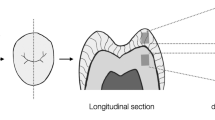Abstract
Fluoride-releasing materials are helpful in the remineralization of enamel in teeth that erodes due to caries. These materials range from glass ionomers, composites, and amalgams that are usually incorporated with filler materials. In this study, a composite that has the potential to be a fluoride-releasing component in dental materials was synthesized using two biocompatible components: calcium fluoride (CaF2) and porcine bone–derived hydroxyapatite (HA). The synthesized material was characterized based on its fluoride release in water. The HA were obtained from porcine bones via calcination and were mixed with CaF2 through manual grinding. The resulting powder mixture was pelletized and sintered at 900 °C to form a disc-shaped green compact. FTIR analysis of the resulting pellet showed that the HA and CaF2 formed fluorapatite (FA), given the absence of OH peaks. The XRD pattern confirmed that a proportion of HA transformed into FA and that there are three phases (HA, FA, and CaF2) present in the pellet. Results of immersion experiments showed that the line of the best-fit model to describe the amount of fluoride released over time is a linear relationship. It was also found that there is an initial high release of fluoride caused by surface wash-off. Furthermore, the synthesized pellets were found to be hydrolytically stable due to the very small mass loss observed even after 16 days of immersion. With the capability to release fluoride and its stability, the synthesized material has the potential to be a cheap alternative material in dental applications.






Similar content being viewed by others
Data availability
The data generated during and analyzed for this study are available from the corresponding author on reasonable request.
References
K. J. Anusavice, “Philips’ Science of Dental Materials 12th ed,” in Elsevier Inc, 2012.
Zhou, S.L., Zhou, J., Watanabe, S., Watanabe, K., Wen, L.Y., Xuan, K.: In vitro study of the effects of fluoride-releasing dental materials on remineralization in an enamel erosion model. J. Dent. 40(3), 255–263 (2012). https://doi.org/10.1016/j.jdent.2011.12.016
Chan, W.D., Yang, L., Wan, W., Rizkalla, A.S.: Fluoride release from dental cements and composites: a mechanistic study. Dent. Mater. 22(4), 366–373 (2006). https://doi.org/10.1016/j.dental.2005.04.028
Janus, A.M., Faryna, M., Haberko, K., Rakowska, A., Panz, T.: Chemical and microstructural characterization of natural hydroxyapatite derived from pig bones. Microchim. Acta. 161(3–4), 349–353 (2008). https://doi.org/10.1007/s00604-007-0864-2
M. R. Mucalo, “Animal-bone derived hydroxyapatite in biomedical applications,” in Hydroxyapatite (HAp) for Biomedical Applications, 2015.
Li, Z., et al.: Effects of fluoridation of porcine hydroxyapatite on osteoblastic activity of human MG63 cells. Sci. Technol. Adv. Mater. 16(3), 35006 (2015). https://doi.org/10.1088/1468-6996/16/3/035006
I. Cacciotti, “Cationic and anionic substitutions in hydroxyapatite,” in Handbook of Bioceramics and Biocomposites, 2016, pp. 145–211.
Dodds, M., Roland, S., Edgar, M., Thornhill, M.: Saliva A review of its role in maintaining oral health and preventing dental disease. BDJ Team. 2(1–8), 1–3 (2015). https://doi.org/10.1038/bdjteam.2015.123
Harhash, A.Y., El Sayad, I.I., Zaghloul, A.G.S.: A comparative in vitro study on fluoride release and water sorption of different flowable esthetic restorative materials. Eur. J. Dent. 11(2), 174–179 (2017). https://doi.org/10.4103/ejd.ejd
Apostol, M., Lobigan, J.L., Cruz, J.K.: Fabrication and characterization of porcine bone-derived hydroxyapatite-alumina biocomposite. Key Eng. Mater. 701, 260–264 (2016). https://doi.org/10.4028/www.scientific.net/KEM.701.260
Kavaloglu Cildir, S., Sandalli, N.: Fluoride release/uptake composite resins of glass-ionomer and polyacid-modified composite resins. Dent. Mater. J. 24(1), 92–97 (2005)
Barandehfard, F., et al.: The addition of synthesized hydroxyapatite and fluorapatite nanoparticles to a glass-ionomer cement for dental restoration and its effects on mechanical properties. Ceram. Int. 42(15), 17866–17875 (2016). https://doi.org/10.1016/j.ceramint.2016.08.122
Sobczak, A., Kowalski, Z., Wzorek, Z.: Preparation of hydroxyapatite from animal bones. Acta Bioeng. Biomech. 11(4), 23–28 (2009)
McCann, H.: Reactions of fluoride ion with hydroxyapatite. J. Biol. Chem. 201(1), 247–259 (1953)
Nikčević, I., Jokanović, V., Mitrić, M., Nedić, Z., Makovec, D., Uskoković, D.: Mechanochemical synthesis of nanostructured fluorapatite/fluorhydroxyapatite and carbonated fluorapatite/fluorhydroxyapatite. J. Solid State Chem. 177(7), 2565–2574 (2004). https://doi.org/10.1016/j.jssc.2004.03.024
Eslami, H., Solati-Hashjin, M., Tahriri, M.: The comparison of powder characteristics and physicochemical, mechanical and biological properties between nanostructure ceramics of hydroxyapatite and fluoridated hydroxyapatite. Mater. Sci. Eng. C. 29(4), 1387–1398 (2009). https://doi.org/10.1016/j.msec.2008.10.033
Glasspoole, E.A., Erickson, R.L., Davidson, C.L.: A fluoride-releasing composite for dental applications. Dent. Mater. 17(2), 127–133 (2001). https://doi.org/10.1016/S0109-5641(00)00051-8
Kuhn, A.T., Wilson, A.D.: The dissolution mechanisms of silicate and glass-ionomer dental cements. Biomaterials. 6(6), 378–382 (1985). https://doi.org/10.1016/0142-9612(85)90096-1
Billington, R.W., Williams, J.A., Pearson, G.J.: Ion processes in glass ionomer cements. J. Dent. 34(8), 544–555 (2006). https://doi.org/10.1016/j.jdent.2005.09.008
Luo, J., Billington, R.W., Pearson, G.J.: Kinetics of fluoride release from glass components of glass ionomers. J. Dent. 37(7), 495–501 (2009). https://doi.org/10.1016/j.jdent.2009.02.007
Wang, Y., et al.: Osteoblastic cell response on fluoridated hydroxyapatite coatings. Acta Biomater. 3(2), 191–197 (2007). https://doi.org/10.1016/j.actbio.2006.10.002
Domingo, C., et al.: Hydrolytic stability of experimental hydroxyapatite-filled dental composite materials. Dent. Mater. 19(6), 478–486 (2003). https://doi.org/10.1016/S0109-5641(02)00093-3
Acknowledgments
The authors would like to acknowledge the Composite Materials Laboratory for accommodating them throughout the experiment.
Funding
This study was funded in part by the PHINMA Teaching and Research Grant.
Author information
Authors and Affiliations
Corresponding author
Ethics declarations
Conflict of interest
The authors declare that they have no conflict of interest.
Additional information
Publisher’s note
Springer Nature remains neutral with regard to jurisdictional claims in published maps and institutional affiliations.
Rights and permissions
About this article
Cite this article
Quindoza, G.M., Hablado, J., De Gala, L.A. et al. In vitro study of fluoride release of calcium fluoride–porcine bone–derived hydroxyapatite composite. J Aust Ceram Soc 57, 803–808 (2021). https://doi.org/10.1007/s41779-021-00573-6
Received:
Revised:
Accepted:
Published:
Issue Date:
DOI: https://doi.org/10.1007/s41779-021-00573-6




